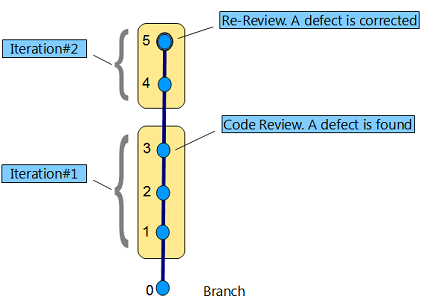What Is Iterative Review
Simple Description of Iterative Peer Code Review
Most code review processes are iterative. First, the author writes some code, then one of the peers reviews the code to find some way to improve it, and makes comments. Then the author codes it up again, and the process can be repeated as necessary.
Below is the schematic illustration of the iterative approach.

Iterations sequence sample
- The code author or moderator creates a new review, adds revision range, and assigns reviewer(s).
- The reviewer inspects the code. During the code review process the reviewer may detect a defect. In this case, the reviewer can add a comment and flag it as a defect. The comment flagged as a defect will signalize to the author that they need to pay extra attention when reworking the code.
- The reviewer rejects the author’s work.
- The author needs to fix the defect that has been indicated by the reviewer. After having fixed all the defects the author must commit all the updates into a repository and then add the new revision range to the review.
- Author reopens the review.
- The reviewer checks whether the defect has been fixed. The reviewer has several options to check and compare author’s changes. The reviewer selects required comparison option to view the author’s changes.
To get familiar with iterative review workflow, please see Iterative Review with Defect Correction topic.